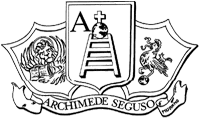Presentazione
DIMANCHE MATIN
Gino Seguso
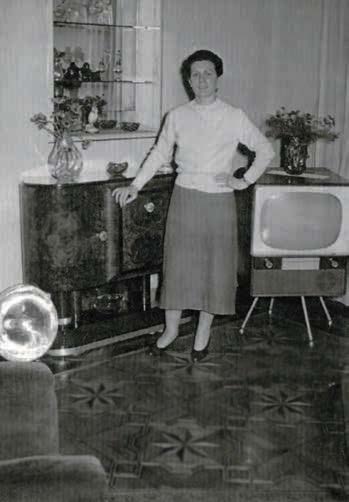
Mrs. Emanuela Fuga Seguso, Master’s wife, in his living room in Santa Maria del Giglio. Second half of the 1950s.
It was a winter’s day and my father, then, was the age I am today (82 years old). We were awaiting a visit from a “delegation” from Tiffany’s. Tiffany has been a client of ours ever since 1948/49. Twice a year they would come to Murano to plan orders and create prototypes of the pieces that would go on sale the following year and thereafter. Gathering ideas, making sketches, creating new pieces, and making new samples in the furnace with a master craftsman like Archimede Seguso, which for John Loring and his collaborators was not only a visual and physical pleasure, but also an unforgettable show. That Sunday at the furnace, after the inevitable embrace followed by smiles, compliments, handshakes and friendly gestures, John Loring had already captured the essence of what dominated the scene around the furnace and remarked: “Cette nouvelle collection on l’appelle Dimanche Matin”. This notebook recalls a series of “ray vases and glasses”. It is a single-themed collection overwhelmingly flooded with light and colour; it offers a feeling of infinity and grandeur, of celebration: “Dimanche Matin” fills both the mind and the heart.
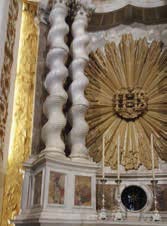
On top: Altars of Udine Cathedral
Second picture: Sculpture detail, Archimede Seguso.
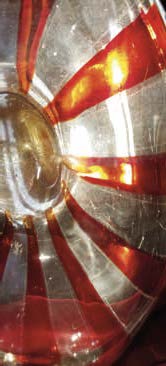
Attualità culturale
“...SONO LE OPERE
CHE HANNO VALORE”
A Venetian lady looking at one of the vases remarks: “It’s the Redentore!!” 1 Was this the inspiration of Archimede? Or did Archimede look at the radiant gold figures of the Louis XIV style ornaments for inspiration? We do not know, but surely in that case he added his own modern take. Or perhaps... The same thing happened to Archimede as Gabriele D’Annunzio reminds us in “Il Fuoco” 2: “I do not understand the reason why the poets of to-day are so indignant at the vulgarity of the present, and complain that they were born either too late or too early. I am convinced that to-day, as always, every man of intelligence has power to create for himself his own beautiful fable of life. We should study the confused whirl of life with the same lively imagination that Leonardo encouraged in his disciples when he advised them to study the stains on the wall, the ashes on the hearth, the clouds, even mud, and similar objects, in order to find there ‘wonderful inventions’ and ‘infinite things’. In the same way, he declared, one can find in the sound of bells every name and every word that can be imagined. That great master knew well that chance—as the sponge of Apelles had already shown—is always the friend of the ingenious artist. For example, I never cease to be astonished at the ease and grace with which chance favors the harmonious development of my inventions.” Surely John Loring that Sunday morning observed the harmonious unfolding of this new joyous invention. The majority of all these vases are solid, extremely masculine, strongly demanding and, at the same time, charming, sweet, and feminine. It is a veritable triumph. Archimede thought up these works and took many days and various steps to create them. The process partially involves the murrina technique, which is prepared in advance; then with another method he formed the composition and blew the work, shaping it. I will not go into detail here as I have decided to publish a notebook of images. I will follow my father once again who used to say when he was babbling on too much: “Xe i fati che conta” “Let the work speak for itself ”
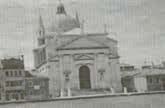

“La Nuova Venezia”, Friday 16 July 2004, p. III
-
Church and Feast of the Redentore: fireworks of the traditional Venetian feast, celebrated on the third Sunday of July every year, to commemorate the Grace of God, received by the city of Venice, which put an end to the plague epidemic of 1575–1577. At the behest of the Doge of the time, Alvise I Mocenigo, a procession to the Church of the Redentore, built on that occasion, was to be held every year.
-
D’Annunzio, Gabriele. Il Fuoco, Prose di romanzi Vol. II, p. 584. Verona: Arnoldo Mondadori Editore, 1953. The novel, set in a Venice at the end of the 19th century, has as its protagonist the young poet Stelio Effrena and talks about one such Seguso (op. cit. p. 786), to whom a long paragraph is dedicated, describing the mastery of this family in the art of glass.
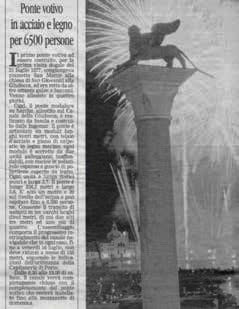
“La Nuova Venezia”, text by Aldo Trivellato, Friday 16 July 2004, p. IX
COLLEZIONE RAGGI
1992
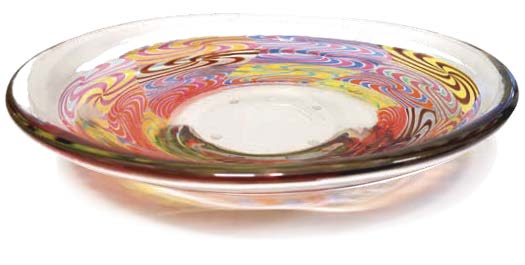
9450 Round clear glass plate with four rows of six polychrome tesserae. Dimensions: diameter 43 cm.

9451 Quadrangular clear glass cup with three rows of eight polychrome tesserae. Dimensions: h 16 x 27 cm.

9452 Round cup decorated with scattered polychrome tesserae and amethyst stains. Dimensions: h 18 x 28 cm.
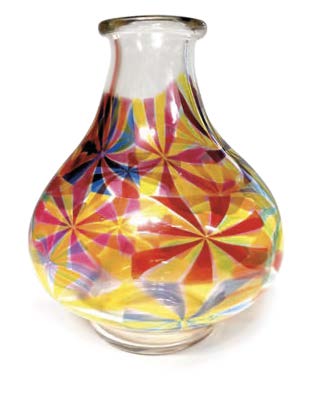
9453 Round vase with cylindrical neck and clear glass base, with three rows of six tesserae in shades of yellow, red and cobalt blue. Dimensions: h 30 x 28.
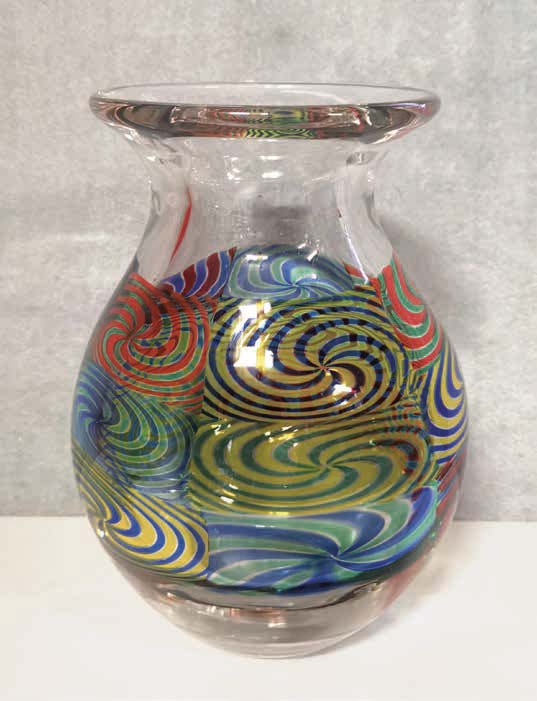
9455 Round vase with enlarged rim around the neck and three rows of five large polychrome tesserae. Dimensions: h 32 cm.

9454 Clear glass plate with three rows of five bright yellow, green and red tesserae. Dimensions; diameter 33 cm.
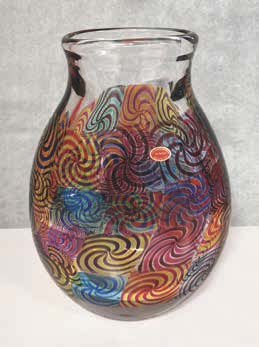
9456 Oval-shaped slightly flattened clear glass vase with four rows of nine thick polychrome tesserae. Dimensions: h 32 cm.
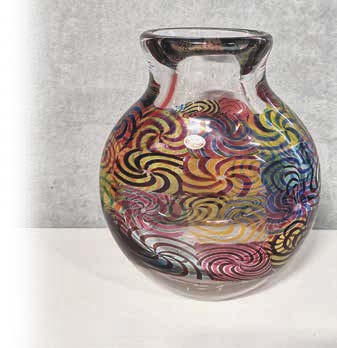
9457 Round clear glass vase with four rows of eight multicoloured tesserae. Dimensions: h 30 x 26 cm.
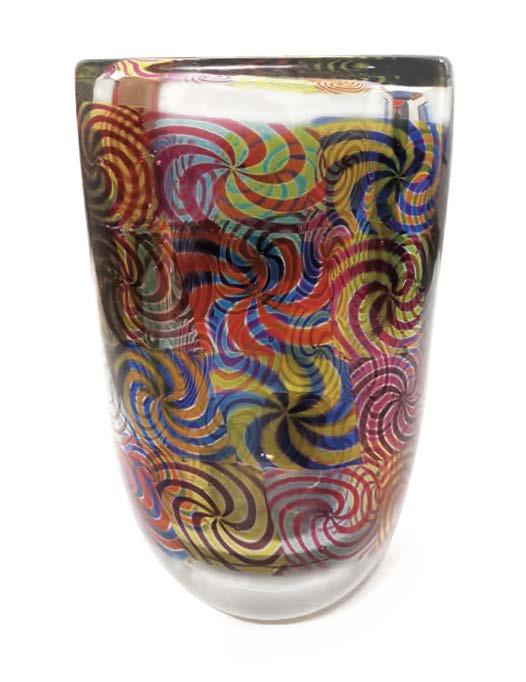
9458 Cylindrical vase with a rounded base, in clear glass with four rows of six large polychrome tesserae. Dimensions: h 29 x 17 cm.
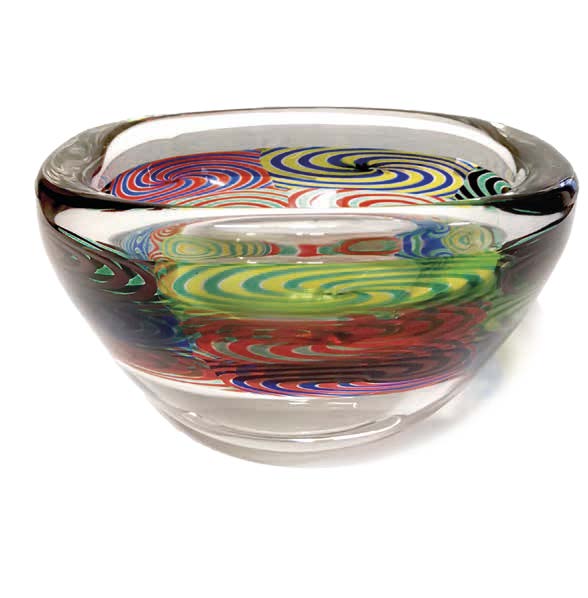
9459 Quadrangular clear glass cup with three rows of five narrow and enlarged polychrome tesserae. Dimensions: h 15 x 26 cm.
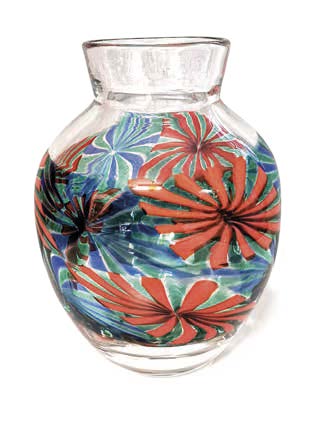
9460 Round vase with conical neck and two rows of six large tesserae in cobalt blue, red and green. Dimensions: h 27 cm.

9461 Round clear glass vase with a narrow, rounded neck and two rows of six large polychrome tesserae. Dimensions: h 22 x 20 cm.

9462 Oval-shaped vase slightly narrow towards the neck, in red glass with two rows of six red and green tesserae. Dimensions: h 29 cm.
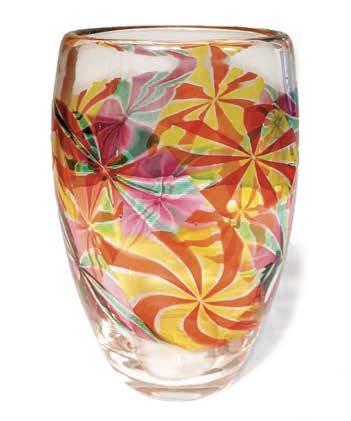
9463 Cylindrical vase narrower at the base with two rows of four very wide tesserae in soft yellow, red and green. Dimensions: h 26 cm.

9464 Round vase with a narrow neck and a cobalt blue thread, in clear glass and cobalt blue with two rows of six large aventurine glass tesserae surrounded by an amethyst thread. Dimensions: h 27 x 19 cm.

9465 Oval-shaped vase with an opened up neck, in clear glass, with four large round tesserae. Dimensions: h 27 cm.
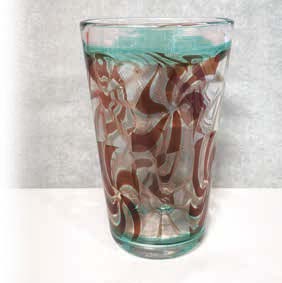
9466 Cylindrical clear glass vase with green stains and two rows of six large tesserae with aventurine and amethyst glass. Dimensions: h 30 x 18 cm.
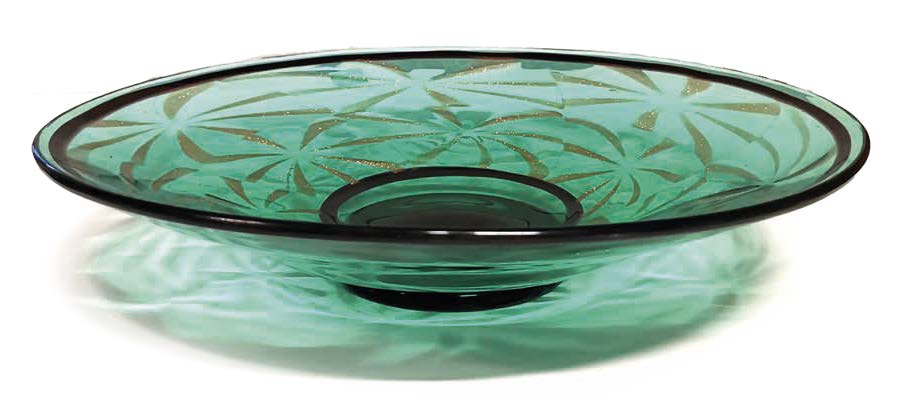
9468 Plate in green glass with black thread on the base and on the upper edge, with two rows of six large tesserae with aventurine glass. Dimensions: h 8 x 36 cm.
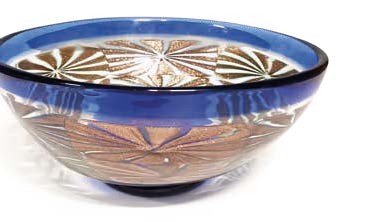
9467 Clear glass cup with cobalt blue thread and cobalt blue band with two rows of six large glass aventurine tesserae. Dimensions: h 12 x 27 cm.

9469 Round cup with slightly opened up edge and clear glass base, in clear glass with two rows of six large compact tesserae in cobalt blue, red and green. Dimensions: h 12 x 24 cm.
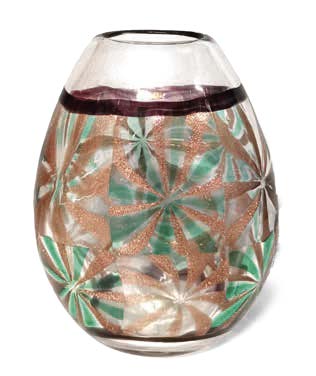
9470 Oval-shaped clear glass vase with two rows of six large green and aventurine glass tesserae surrounded by an amethyst thread. Dimensions: h 23 cm.
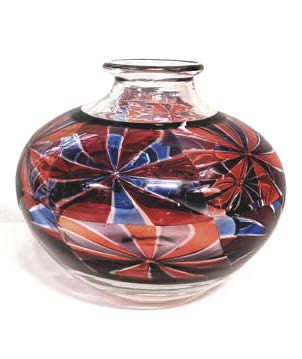
9471 Round vase with narrow neck, in clear glass, with two rows of six cobalt blue, red and amethyst tesserae, surrounded by an amethyst thread. Dimensions: h 17 x 20 cm.
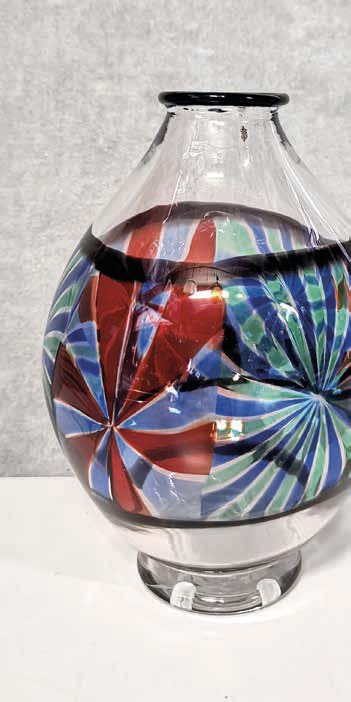
9472 Round vase with clear glass base and narrow neck with amethyst thread, in clear glass with a row of large tesserae with amethyst outline.
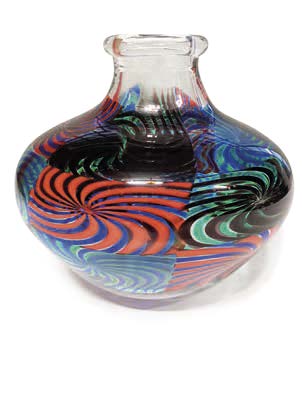
9473 Round vase with cylindrical neck, in clear glass, with three rows of six large tesserae in red, cobalt blue, green and amethyst. Dimensions: h 18 x 20 cm.
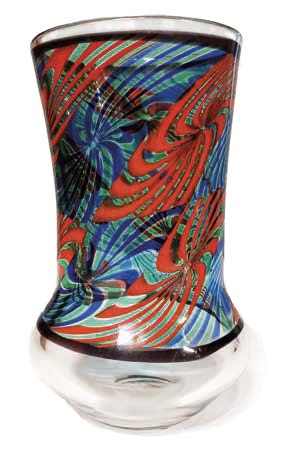
9474 Cylindrical vase enlarged towards the base, in clear glass, with two rows of six very wide tesserae surrounded by an amethyst thread. Dimensions: h 24 cm.

9475 Oval-shaped vase with slightly opened up neck, in clear glass, with two rows of four glass aventurine tesserae alternating with red glass bands, surrounded by an amethyst thread. Dimensions: h 23 cm.

9476 Cylindrical vase enlarged towards the base, with two rows of six red, green and amethyst tesserae completely covering the surface of the work.
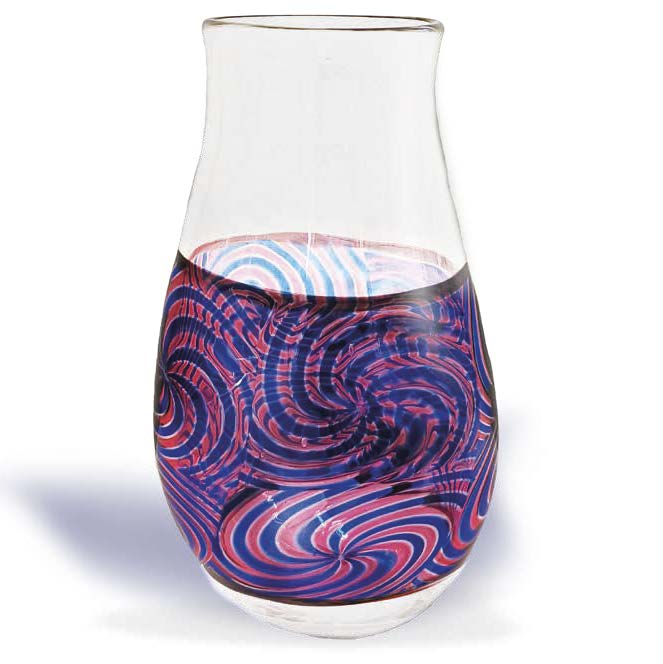
9477 Oval-shaped vase with cylindrical neck, in clear glass, with two rows of four large lilac and cobalt blue tesserae, surrounded by an amethyst thread. Dimensions: h 26 cm. Dimensions: h 26 cm.

9478 Round vase with narrow neck, in clear glass, with two rows of two tesserae alternating with green glass bands, surrounded by an amethyst thread. Dimensions: h 23 cm.

9479 Round vase with narrow neck, decorated with two small curled handles, in clear glass with a central band composed of two rows of six polychrome tesserae. Dimensions: h 21 x 22 cm.

9480 Round cup with slightly opened up edge, in clear glass with two rows of four very wide pink and cobalt blue tesserae surrounded by a green thread. Dimensions: h 11 x 20 cm.
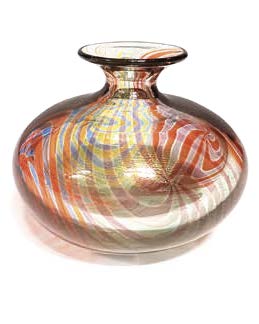
9481 Round vase with a very narrow bottleneck, in clear glass with 24 carat gold leaf and a row of six large polychrome tesserae decorating the entire surface of the work. Dimensions: h 10 x 14 cm.
